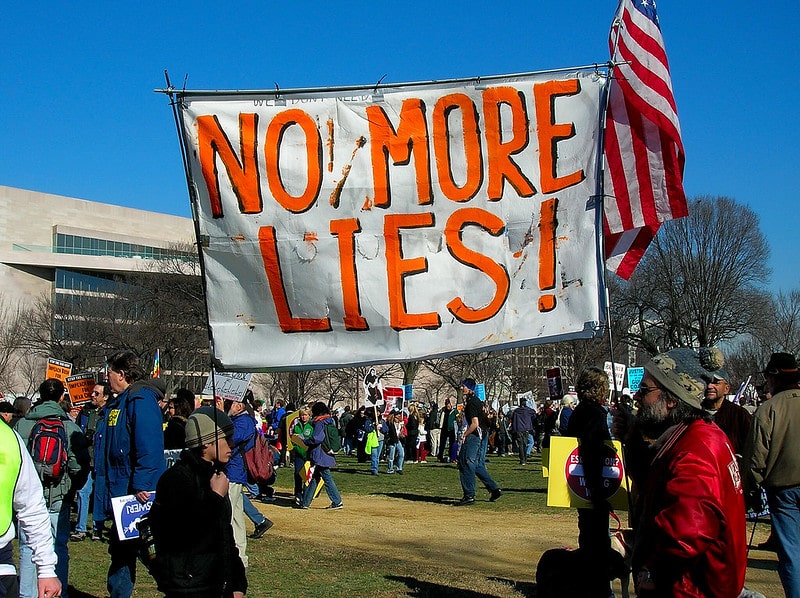The Iraq War was spawned by a deadly combination of political depravity and media complicity. Unfortunately, on the twentieth anniversary of the war, both elements of that conspiracy are being whitewashed. Instead, politicians and their pundit accomplices are prattling as if the Iraq war was a well-intentioned mistake, not a crime against humanity.
In the days after 9/11, when pollsters asked Americans who they thought had carried out the 9/11 attacks, only 3 percent of respondents suggested Iraq or Saddam Hussein as culprits. But President George W. Bush and Vice President Dick Cheney worked ceaselessly to convince Americans that Saddam was the 9/11 culprit. Official propaganda trumpeting the Saddam/al-Qaeda link was the linchpin for exploiting 9/11 to justify war. A February 2003 poll found that 72 percent of Americans believed that Saddam was “personally involved in the September 11 attacks.” Shortly before the March 2003 invasion, almost half of all Americans believed that “most” or “some” of the 9/11 hijackers were Iraqi citizens. Only 17 percent of respondents knew that none of the hijackers was Iraqi.
In his official notification of invasion sent to Congress (in lieu of a declaration of war) on March 18, 2003, Bush declared that he was attacking Iraq “to take the necessary actions against international terrorists and terrorist organizations, including those nations, organizations, or persons who planned, authorized, committed, or aided the terrorist attacks that occurred on September 11, 2001.” Bush tied Saddam to 9/11 even though confidential briefings he received informed him that no evidence of any link had been found. Three years after the war started, Bush publicly admitted that Saddam had nothing to do with 9/11.
On March 17, 2003, Bush also justified invading Iraq by invoking UN resolutions purportedly authorizing the U.S. “to use force in ridding Iraq of weapons of mass destruction.” In a speech giving Saddam 48 hours to abdicate power, Bush declared, “Intelligence gathered by this and other governments leaves no doubt that the Iraq regime continues to possess and conceal some of the most lethal weapons ever devised.” In the weeks and months after the fall of Baghdad, Bush repeatedly asserted that U.S. forces had discovered WMDs or that Saddam had weapons programs. “We found the weapons of mass destruction. We found biological laboratories,” Bush declared to journalists on May 29, 2003. Five weeks later, he again claimed vindication because “we found a biological lab” in a truck trailer. However, CIA investigators concluded that the trailer had nothing to do with an Iraqi WMD program. False claims by the Bush administration on Saddam seeking uranium in Niger sparked an uproar and leaks seeking to destroy the former ambassador who exposed the sham.
In June 2003, Bush repeatedly denounced “revisionist historians” who kept asking about the missing WMDs. In a November 12, 2003 interview with the BBC’s David Frost, Bush declared that he had sent a team to Iraq “to find the weapons or the intent of weapons.” Bush did not reveal how he defined “the intent of weapons.” The following month, Bush told ABC News that the war was justified because there was “the possibility that [Saddam] could acquire weapons.” In January 2004, David Kay—the man Bush chose to head the search for WMDs in Iraq—testified to Congress that “we were almost all wrong,” as far as Iraq possessing WMDs. Kay’s testimony demolished one of the prime pretexts for the war.
Bush responded by portraying the lack of evidence as proof of his courage. On February 8, 2004, Bush justified invading Iraq because Saddam “had the ability to make weapons at the very minimum.” This is like justifying a violent no-knock raid on someone’s house because they could have purchased gunpowder and tin cans.
In a March 2, 2004 speech to Homeland Security Department employees, Bush offered a new justification for invading Iraq: “America will not allow terrorists and outlaw regimes to threaten our Nation and the world with the world’s most dangerous technologies.” The mere suspicion that a nation might have “dangerous technologies” justified devastating their land.
But what did George W. Bush really think? That mystery was solved a few weeks later at the annual Washington dinner for the Radio and Television Correspondents Association. Bush performed a skit featuring slides showing him crawling around the Oval Office peeking behind curtains. Bush quipped to the poohbah attendees: “Those weapons of mass destruction have got to be somewhere…Nope, no weapons over there…Maybe under here?” The crowd loved it and The Washington Post headlined its report on the evening: “George Bush, Entertainer in Chief.” Greg Mitchell, the editor of Editor & Publisher, labeled the performance and the press’s reaction that night as “one of the most shameful episodes in the recent history of the American media and presidency.” By the time of Bush’s performance, hundreds of American soldiers and tens of thousands of Iraqi civilians had already been killed.
Most of the media had embedded themselves for the Iraq war long before that dinner. The Washington Post buried pre-war articles questioning the Bush team’s shams on Iraq; their award-winning Pentagon correspondent Thomas Ricks complained, “There was an attitude among editors: ‘Look, we’re going to war, why do we even worry about all this contrary stuff?’” Instead, before the war started, the Post ran 27 editorials in favor of invasion and 140 front-page articles supporting the Bush administration’s case for attacking Saddam. PBS’s Bill Moyers noted that “of the 414 Iraq stories broadcast on NBC, ABC and CBS nightly news, from September 2002 until February 2003, almost all the stories could be traced back to sources from the White House, the Pentagon, and the State Department.” Jim Lehrer, the host of government-subsidized PBS Newshour, explained his timidity in 2004: “It would have been difficult to have had debates [about invading Iraq]…you’d have had to have gone against the grain.” Lehrer’s admission did not disgrace him since groveling to officialdom is the job description for Washington journalists.
In his 1971 opinion on the Pentagon Papers case, Justice Hugo Black declared that a free press has “the duty to prevent any part of the government from deceiving the people and sending them off to distant lands to die of foreign fevers and foreign shot and shell.” But during the Iraq War, most of the media preferred to trumpet official lies instead of exposing them.
A 2005 American University survey of hundreds of journalists who covered Iraq concluded: “Many media outlets have self-censored their reporting on the conflict in Iraq because of concern about public reaction to graphic images and details about the war.” Individual journalists commented:
“In general, coverage downplayed civilian casualties and promoted a pro-U.S. viewpoint. No U.S. media show abuses by U.S. military carried out on regular basis.”
“Friendly fire incidents were to show only injured Americans, and no reference made to possible mistakes involving civilians.”
“The real damage of the war on the civilian population was uniformly omitted.”
The media sugarcoated the war and almost always refused to publish photos incriminating the U.S. military. The Washington Post received a leak of thousands of pages of confidential records on the 2005 massacre at Haditha, including stunning photos taken immediately after Marines killed 24 civilians (mostly women and children). Though the Post headlined its exclusive story, “Marines’ Photos Provide Graphic Evidence in Haditha Probe,” the article noted that “Post editors decided that most of the images are too graphic to publish.” The Post suppressed the evidence at the same time it continued deferentially reporting official denials that U.S. troops committed atrocities.
In 2007, two Apache helicopters targeted a group of men in Baghdad with 30 mm. cannons and killed kill up to 18 people. Video from the helicopter revealed one helicopter crew “laughing at some of the casualties, all of whom were civilians, including two Reuters journalists.” “Light ’em all up. Oh yeah, look at those dead bastards,” one guy on the recording declared. Army Corporal Chelsea Manning leaked the video to Wikileaks, which disclosed it in 2010. Wikileaks declared on Twitter: “Washington Post had Collateral Murder video for over a year but DID NOT RELEASE IT to the public.” Wikileaks also disclosed thousands of official documents exposing U.S. war crimes and abuses, tacitly damning American media outlets that chose to ignore or shroud atrocities.
In 2007, Fox News talk show host Bill O’Reilly declared that at the beginning of the war in Iraq, “everybody in the country [was] behind it, except the kooks.” The “kooks” included UN weapons inspectors, the head of the International Atomic Energy Agency, and many foreign governments. The “kook” label was also attached to Antiwar.com, The American Conservative, Counterpunch, the Future of Freedom Foundation, and an array of individual journalists who often found closed doors to their submissions. Likewise, the hundreds of thousands (if not millions) of protestors who took to the streets of American cities to oppose the war were redefined into a laughingstock.
In his rush to war, President Bush showed boundless bad faith—followed by boundless righteousness after his lies were exposed. By the summer of 2008, only 22 percent of Americans approved of Bush and 41 percent said he was the “worst president ever.” But the same media outlets that championed the Iraq War helped resurrect Bush’s public image a decade later. Bush was exalted like the second coming of George Washington for his slams against the Trump administration. By early 2018, a poll showed that 61 percent of Americans approved of Bush, and his support among Democrats quintupled, from 11 percent in early 2009 to 54 percent now. The key to Bush’s rehabilitation was burying his Iraq War record in the Memory Hole.
The media played the same trick to expunge its own tawdry Iraq record. Four years ago, The Washington Post spent a king’s ransom to produce and run a Super Bowl ad on its “Democracy Dies in the Darkness” motto. At that time, the Post was whipping up RussiaGate hysteria and reaping torrents of new subscribers. The Super Bowl ad, a paean to reporters, declared, “When we go off to war…knowing keeps us free.”
But kowtowing leaves people dead. Twenty years after the start of the Iraq War, President Biden is dragging America deeper into a foreign conflict that could spiral into World War III. Most of the mainstream media is again parroting whatever the U.S. government or its foreign lackeys say about the Russia-Ukraine conflict.
Lies are political weapons of mass destruction, obliterating all limits on government power. The Iraq War should have taught Americans not to trust presidents or pundits who seek to unleash mass carnage. But don’t trust the Washington elite to ever learn or admit that lesson.








